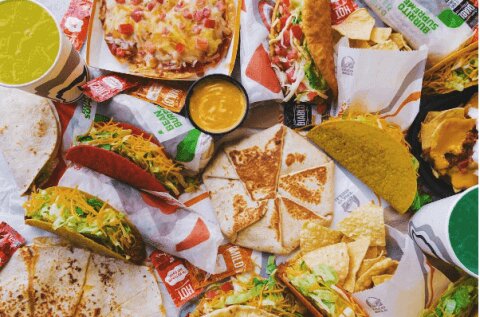Addressing concerns of bloating, fatigue, and cravings may be as simple as exploring low sodium options at your favorite fast-food joints. We’ve discovered a perfect compromise, allowing you to indulge in your beloved fast-food spots while opting for dishes lower in sodium.
While it might seem challenging to find low sodium alternatives at fast-food establishments, the landscape is changing. These restaurants are adjusting their menus to cater to the growing health-consciousness among customers who are increasingly mindful of their dietary choices.
Many popular fast-food chains now offer progressively more low sodium meal options. Additionally, healthier alternatives like fruit cups or fresh fruit side dishes are making their way onto menus.
The prevalence of high-sodium fast food consumption has peaked in today’s society. Despite their known health risks, favorites like burgers, pizzas, and greasy fries remain popular due to their high fat, sugar, and salt content, enhancing their flavor profiles.
The cycle of consuming high sodium foods can lead to increased thirst, prompting consumers to opt for unhealthy beverages. Keeping track of your dietary choices, especially if you’re a fast-food enthusiast, can be challenging.
However, rest assured that low sodium options can be equally delicious, providing a healthier alternative without compromising on taste. These choices are increasingly accessible, making it easier to prioritize your health while still enjoying the convenience of fast food.
Low Sodium Fast Food Options:

Low Sodium Fast Food Options are now available at various popular fast-food establishments. Here, we highlight some diet-friendly choices from well-known fast-food companies, ensuring you can enjoy the convenience of fast food without compromising on your low sodium requirements.
1. McDonald’s:
Fruit & Maple Oatmeal:
When exploring Low Sodium Fast Food Options, McDonald’s might not be the immediate choice that comes to mind.
Nevertheless, they offer several healthier alternatives, including the Fruit and Maple Syrup Oatmeal. This low sodium meal consists of oatmeal, sliced apples, light cream, and a cranberry-raisin blend.
With only 150 mg of salt per serving, equivalent to approximately 7% of the recommended Daily Value (DV), it stands as a suitable choice for those seeking to manage their sodium intake.
Additionally, it provides 4 grams of fiber per serving, contributing to a more balanced nutritional profile and potentially aiding in the intake of essential minerals such as iron and potassium.
Hotcakes:
Hotcakes at McDonald’s stand out as a popular breakfast option that also qualifies as a low sodium fast food choice. Each serving contains 550 mg of sodium, constituting 24 percent of the daily value.
While the hotcakes do contain increased levels of carbohydrates, fats, and sugars, they also provide essential nutrients like calcium, potassium, and iron. To enhance the low sodium aspect, it’s advisable to skip salted whipped butter, thereby reducing the overall sodium content to 480 mg for the three hotcakes.
2. Subway:
Veggie Delight:
Subway, while not widely recognized for its healthy choices, offers a vegetarian delight option that qualifies as one of the low sodium fast food options. This vegetable-packed sandwich, served on 9-grain whole wheat bread, features a medley of wholesome ingredients, including tomatoes, onions, lettuce, green peppers, and cucumbers.
With minimal saturated fat and nearly negligible excess sodium, it weighs in at approximately 280mg. For additional protein, customers have the option to customize their sandwich with chicken.
3. Pizza Hut:

Veggie Lovers Small Thin ‘N Crispy Slice:
When the craving for a slice hits, it’s easy to succumb to the temptation of an entire pizza. Instead, satisfy your hunger responsibly by ordering a slice of Pizza Hut’s Veggie Lovers. While pizza is commonly associated with high sodium and calorie content, this option offers a health-conscious alternative.
With just 100 calories per slice, you not only benefit from reduced calorie and sodium levels but also gain antioxidants from the green peppers, onions, and olives. Indulge in a slice without compromising your health or waistline, as it contains only 1.5 grams of trans fat and 3.5 grams of fat.
4. Starbucks:
PB&J Protein Box:
In recent years, Starbucks has introduced a range of protein boxes, thoughtfully balanced to supply the necessary nutrients for sustaining higher energy levels throughout the day. The PB&J Protein Box, for instance, offers a blend of protein, carbohydrates, and fats.
While delivering only 570 mg of sodium, this protein box includes whole grain bread, cheese, a yogurt dip, as well as a selection of fruits and veggies to munch on. It stands out as a substantial meal option that caters to your hunger while adhering to your daily sodium limit.
5. Burger King:
Chicken Nuggets:
When it comes to managing your sodium intake, Burger King’s chicken nuggets emerge as a healthier alternative compared to the restaurant’s burgers and sandwiches. A 4-piece serving contains 495 mg of sodium, constituting 22 percent of the Daily Value (DV), which is less than half of a Whopper.
These chicken nuggets provide 9 grams of protein and fewer than 200 calories per serving, making them a reasonably low-sodium option. The key is to avoid sauces and condiments as much as possible, as spicy or savory sauces tend to have a high sodium content, affecting the overall taste.
6. Taco Bell:
Crunchy Taco with Beef:
Opting for a beef crunchy taco in the “Fresco Style” at Taco Bell can be a favorable choice for those looking for low sodium fast food options. This taco, with zero-calorie/zero-sodium tomatoes replacing the Cheddar Cheese, offers 140 calories, 3 grams of fiber, and 6 grams of protein (excluding the cheese, which adds 30 calories and 40 milligrams of sodium).
The emphasis on protein and fiber makes this taco filling while keeping the sodium content lower. For a satisfying and lower-sodium lunch, choosing two of these beef tacos results in only 540 mg of sodium, significantly less than the sodium content in one Taco Bell Beef Burrito Supreme (1,110 milligrams).
Additionally, Taco Bell offers a chicken crunchy taco option for added variety.
7. Dunkin’ Donuts:

Multigrain Oatmeal:
While indulging in your coffee run, the temptation to add a doughnut to your breakfast may arise. However, a wiser and healthier option at Dunkin’ Donuts is to opt for one of their nutritious oatmeal choices, such as the Multigrain Oatmeal.
This oatmeal stands out as an excellent breakfast alternative, resembling a carefully crafted cereal with wholesome ingredients. It boasts a modest salt content, with a maximum of 250 mg. For an added touch, consider enhancing your oatmeal by sprinkling dried fruit on top.
Dunkin’ Donuts’ Multigrain Oatmeal is a flavorful and satisfying low sodium fast food option, providing a balanced start to your day.
8. Chipotle:
Taco:
Customizing your order at Chipotle makes it easy to align your tacos with your dietary preferences and reduce the sodium content of your meal.
For instance, a chicken taco with romaine lettuce, crispy corn tortilla, fajita veggies, sour cream, and black beans contains 233 mg of sodium, equivalent to 10% of the daily value.
Likewise, opting for steak or carnitas instead of chicken helps maintain a lower overall sodium level, with the total salt content reduced to 240 mg or 280 mg.
Chipotle offers flexibility in crafting your tacos, providing a low sodium fast food option that caters to your specific taste and nutritional requirements.
9. CHICK-FIL-A:
Grilled Chicken Nuggets:
Chick-fil-A stands out for its delectable chicken offerings among various fast-food establishments. While many of their menu items tend to be high in sodium, opting for the grilled or breaded meat choices presents a low-sodium alternative to the traditional chicken sandwich. The grilled chicken nuggets emerge as an excellent option.
In a serving of eight, you’ll only consume 440 mg of salt, and when paired with honey mustard sauce, the sodium intake reaches 515 mg. What adds to the delight is that each serving provides 25 grams of protein and 140 calories, contributing to a balanced nutritional profile that counteracts the sodium content. Chick-fil-A’s grilled chicken nuggets offer a flavorful yet low sodium fast food option for those seeking a healthier choice.
10. Wendy’s:
Baked Potato:
Wendy’s classic baked potato stands out as one of their fundamental offerings, boasting a mere 40 mg of salt per serving, equivalent to approximately 2% of the daily value. This nutritious choice is also rich in iron, potassium, and fiber, providing 7 grams of protein in each serving.
For a customizable and healthy approach, you can order a plain potato and add your preferred toppings, such as herbs and vegetables. Alternatively, you may opt for the Sour Cream with Chive topping, which maintains a low sodium content at just 55 mg per serving. This option offers a balanced nutritional profile with 270 calories and a noteworthy 1,560 milligrams of potassium.
11. In-N-Out:
Protein Style Hamburger:

With 370 milligrams of sodium and 240 calories, this burger opts for lettuce instead of a bun, a choice that doesn’t compromise on taste. By ordering it “protein-style,” you can significantly reduce the sodium content of your burger while maintaining its deliciousness.
Comparatively, a regular hamburger with the bun contains 650 milligrams of sodium, making the “protein-style” version a saving grace with only 370 milligrams – a noteworthy reduction of 280 milligrams. This choice also translates to a calorie saving of 150 and a carbohydrate reduction of 18 grams by skipping the bread.
Read: CityTime Login – A Comprehensive Guide In 2024!
Why Should You Be Concerned About Your Salt Intake?
For individuals at risk of hypertension, hypernatremia, or heart failure, careful monitoring of salt intake is essential. Excessive sodium consumption is linked to an increased risk of high blood pressure.
Individuals with renal illness should also be cautious, as an abundance of sodium may contribute to kidney disease. Even for those without existing conditions, reducing salt intake is a preventive measure against potential health issues.
According to the American Heart Association (AHA), the average American consumes over 3,400 mg of salt daily. Many individuals, concerned about their health, may consider investing in expensive healthy meal delivery services.
However, a practical alternative is eliminating high-sodium fast food options from your diet. In the fast-food drive-thru, where burgers and fries can exceed 3,000 mg of sodium, there is ample opportunity to make choices that reduce overall sodium intake.
Is It Possible to Get Low Sodium Fast Food?
What prompts our craving for fast food? The heightened salt content prevalent in most fast-food offerings enhances their allure, triggering increased hunger and thirst and prompting us to indulge in more fast food.
While locating low-sodium fast food options may pose a challenge, it is not an insurmountable task. Many fast-food establishments are revising their menus to better align with the health-conscious preferences of their customers.
The introduction of low-sodium fast food alternatives, free from gluten, dairy, sugar, and excessive salt, reflects the growing awareness of concerns related to blood pressure and organ health. The adaptation of these low-sodium options is a logical response to evolving dietary needs.
Fast food may not be the optimal choice for a low-sodium diet. However, if faced with limited alternatives and the need to grab a quick meal, arming yourself with essential knowledge is crucial for making the most informed decisions.
Continue reading to discover effective ways to manage a low-sodium diet while still savoring the offerings of your favorite fast-food chains.
Read: Garnethillskids.Com – Guide to Children’s Online Shopping!
Where Can I Get Low-Sodium Fast Food?

While the available low-sodium fast food choices may not always align with the FDA’s precise definition of “low sodium,” we have compiled a list of recommendations to assist you in maintaining a balanced salt intake:
- Steer clear of fatty toppings, sides, dressings, and spreads: These items not only contribute excess calories but are often high in salt or sugar. Request extras like bacon, croutons, or salad dressings on the side to have better control over your salt intake.
- Opt for grilled, broiled, or baked meats: Fried, breaded, and deli meats may be tempting, but they typically contain higher added salt. Choose cooking methods that involve grilling, broiling, or baking for a healthier alternative.
- Avoid super-sized items: Terms like “jumbo,” “super-size,” or “double” are clear indicators of excessive sodium, calorie, and unhealthy fat content. Opt for smaller portions to maintain a balanced diet.
- Keep it simple and choose water: While most beverages have minimal salt content, adopting a habit of drinking water during meals is a healthy choice.
For those menstruating, pregnant, or breastfeeding, maintaining a low-sodium diet is crucial. Prepare in advance to identify low-sodium fast food options that align with your dietary needs.
We meticulously examined the menus of prominent restaurants to unveil low-sodium choices, with the sodium content per dish indicated in brackets.
Low Sodium Fast Food Dishes You Can Make at Home:

With a variety of options for dining out, you can also make positive changes in your home cooking. Instead of using restaurant dressings, consider opting for a reduced-fat balsamic vinaigrette on your salads.
Preparing low-sodium meals at home is simpler than you might imagine. Quick salads and vegan sandwiches with minimal salt can be easily whipped up for convenient meals.
The advantage of being able to control the amount of salt, sugar, and fat in your homemade meals is significant, giving you greater command over your dietary choices.
Creating low-sodium fast food at home is straightforward!
- Be aware of nutritional details before purchasing anything.
- Check product labels to identify sodium content before making a purchase.
- Processed, dried, and smoked meats typically have high salt content.
- Exercise caution with canned fruits and veggies, which often contain elevated sodium levels.
- Opt for canned products labeled ‘low sodium’ or ‘sodium-free.’
- Thoroughly rinse ingredients before use.
The internet serves as an excellent resource for discovering low-sodium recipes. Below is a list of home-prepared meals with 300 mg or less of salt:
- Homemade Mixed Vegetable Burgers
- Lemon Pepper Tilapia with Mushrooms
- Fish and Chips
- Mixed Spice Burgers
- Grilled Basil Chicken and Tomato
- Whole Wheat Veggie Pizza
- Roasted Chicken with Peppers and Tomato
- Side Salads or Chicken Salad
- Baked Meats
Conclusion:
Despite numerous efforts to enhance awareness regarding the potential and expected impacts of fast food on health, convincing consumers to abstain from it remains challenging. A potential solution lies in promoting healthier meals by reducing salt intake, advocating for decreased sodium levels, even within the realm of fast food. There are likely low sodium fast food alternatives at your preferred fast-food establishment, provided you know where to find them.
Also Read:
- System_Application_Answer_0010 – Key Insights and Solutions!
- Awesome Tanks Unblocked – 2024 Free Games Guide!
- Kindle Publishing Login – A Comprehensive Guide In 2024!
